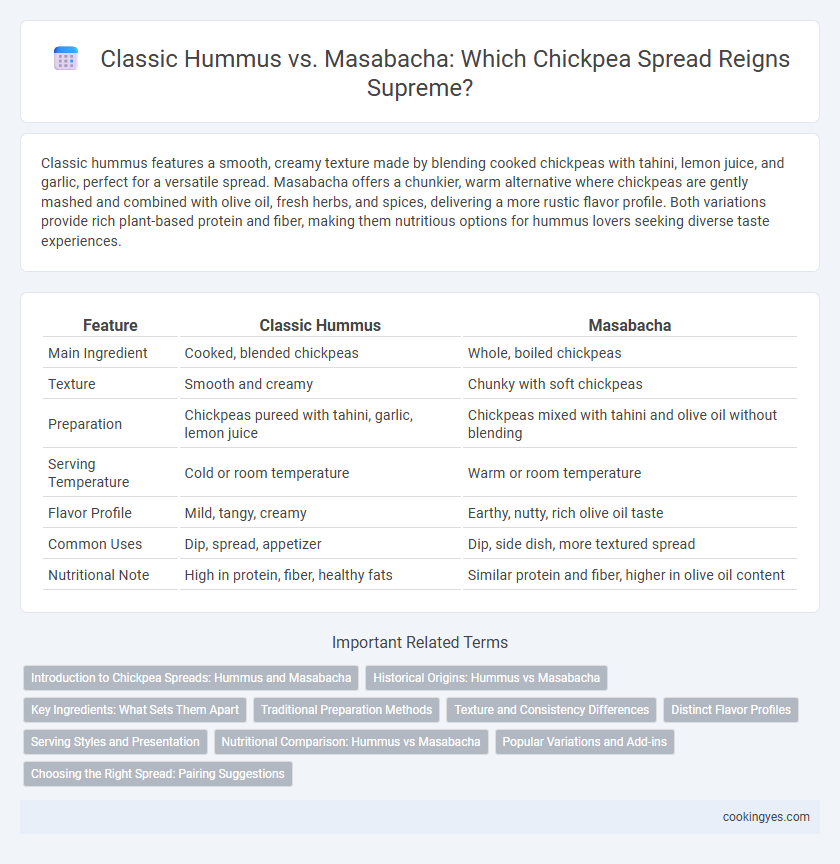Classic hummus features a smooth, creamy texture made by blending cooked chickpeas with tahini, lemon juice, and garlic, perfect for a versatile spread. Masabacha offers a chunkier, warm alternative where chickpeas are gently mashed and combined with olive oil, fresh herbs, and spices, delivering a more rustic flavor profile. Both variations provide rich plant-based protein and fiber, making them nutritious options for hummus lovers seeking diverse taste experiences.
Table of Comparison
| Feature | Classic Hummus | Masabacha |
|---|---|---|
| Main Ingredient | Cooked, blended chickpeas | Whole, boiled chickpeas |
| Texture | Smooth and creamy | Chunky with soft chickpeas |
| Preparation | Chickpeas pureed with tahini, garlic, lemon juice | Chickpeas mixed with tahini and olive oil without blending |
| Serving Temperature | Cold or room temperature | Warm or room temperature |
| Flavor Profile | Mild, tangy, creamy | Earthy, nutty, rich olive oil taste |
| Common Uses | Dip, spread, appetizer | Dip, side dish, more textured spread |
| Nutritional Note | High in protein, fiber, healthy fats | Similar protein and fiber, higher in olive oil content |
Introduction to Chickpea Spreads: Hummus and Masabacha
Classic hummus, a creamy blend of chickpeas, tahini, lemon juice, and garlic, offers a smooth texture and balanced flavor profile perfect for dipping or spreading. Masabacha, often called warm hummus, features whole chickpeas with a thicker, chunkier consistency and is typically served warm with olive oil and spices for a heartier taste. Both chickpea spreads celebrate the legume's versatility, highlighting different textures and flavor intensities rooted in Middle Eastern cuisine.
Historical Origins: Hummus vs Masabacha
Classic hummus traces its origins to the Levant region, dating back to ancient Middle Eastern civilizations where chickpea spreads were staples in local diets. Masabacha, a variation from Jerusalem, incorporates whole chickpeas and a more textured consistency, reflecting regional culinary adaptations rooted in Palestinian traditions. Both emphasize chickpeas and tahini but represent distinct historical and cultural narratives within Middle Eastern gastronomy.
Key Ingredients: What Sets Them Apart
Classic hummus blends smooth chickpeas, creamy tahini, garlic, lemon juice, and olive oil to create its signature velvety texture and balanced flavor. Masabacha, a warm chickpea spread, highlights whole chickpeas with tahini, garlic, and often a spicy touch of chili and cumin, retaining a chunkier consistency. The key difference lies in texture and seasoning emphasis, with classic hummus being smooth and mild, while masabacha is more textured and robustly spiced.
Traditional Preparation Methods
Classic hummus is traditionally prepared by soaking dried chickpeas overnight, boiling them until soft, and then blending with tahini, garlic, lemon juice, and olive oil to achieve a smooth, creamy texture. Masabacha involves using cooked chickpeas with skins intact, combined with tahini and warm chickpea broth to create a chunkier, more textured spread often served warm. Both methods rely heavily on fresh, high-quality ingredients and emphasize the balance of flavors through meticulous hand-mixing techniques.
Texture and Consistency Differences
Classic hummus features a smooth, creamy texture achieved by blending chickpeas with tahini, olive oil, lemon juice, and garlic until velvety. Masabacha, or balila, offers a chunkier consistency with whole chickpeas gently cooked and lightly mashed, providing a heartier, more rustic mouthfeel. The contrast in texture distinguishes classic hummus as a dip with a silky finish, while masabacha embraces a robust, grainier spread ideal for hearty servings.
Distinct Flavor Profiles
Classic hummus offers a smooth and creamy texture with a balanced blend of tahini, garlic, lemon, and olive oil, highlighting a mild, nutty flavor. Masabacha features a chunkier consistency, often incorporating whole chickpeas and a zestier taste with added spices like cumin and paprika, creating a more robust and textured experience. Both spreads showcase chickpeas but cater to different flavor preferences through their unique preparation methods and ingredient combinations.
Serving Styles and Presentation
Classic hummus is traditionally served smooth in a shallow bowl, garnished with olive oil, whole chickpeas, and a sprinkle of paprika or sumac, creating a visually simple yet appetizing presentation. Masabacha, a warm chickpea spread, is often presented with whole chickpeas intact and a drizzle of tahini and olive oil, emphasizing its textured and rustic style. Both spreads highlight chickpeas but differ in temperature and consistency, influencing their serving styles and visual appeal.
Nutritional Comparison: Hummus vs Masabacha
Classic hummus typically contains blended chickpeas, tahini, olive oil, lemon juice, and garlic, offering a good balance of protein, fiber, and healthy fats with approximately 70 calories and 2 grams of protein per tablespoon. Masabacha, a warm chickpea spread with whole chickpeas and a drizzle of olive oil and spices, delivers a higher fiber content and more intact nutrients due to less processing, contributing to improved digestion and sustained energy. Both spreads are rich in plant-based protein and healthy fats but Masabacha provides a slightly higher antioxidant profile and a heart-healthy dose of unsaturated fats from the olive oil drizzle.
Popular Variations and Add-ins
Classic hummus features smooth, creamy chickpeas blended with tahini, lemon juice, garlic, and olive oil, offering a versatile base for countless add-ins such as roasted red peppers, pine nuts, or smoked paprika. Masabacha, a popular variation also known as warm chickpea salad, retains whole chickpeas and incorporates olive oil, fresh parsley, and a touch of cumin for a heartier texture and robust flavor. Both spreads serve as foundations for diverse toppings like toasted pita, za'atar, or caramelized onions, enhancing their savory richness and appeal in Mediterranean cuisine.
Choosing the Right Spread: Pairing Suggestions
Classic hummus offers a smooth, creamy texture with flavors of tahini, lemon, and garlic, making it ideal for pairing with fresh vegetables, pita bread, and grilled meats. Masabacha, a chunkier chickpea spread enriched with whole chickpeas, warm spices, and olive oil, complements more robust dishes like roasted vegetables, falafel, and hearty sandwiches. Choosing between classic hummus and masabacha depends on desired texture and flavor intensity, with classic hummus suited for delicate pairings and masabacha enhancing bold, savory meals.
Classic Hummus vs Masabacha for chickpea spreads Infographic

 cookingyes.com
cookingyes.com